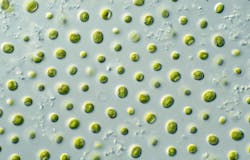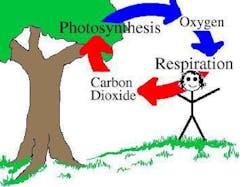Microalgae May Yield a Macro Impact on the Environment
This is the first of what will probably be a multi-part piece, something new for me after writing Clark’s Remarks for the past nine years.
Recently, I was invited to participate in what could/should well be the most exciting project of my career. No, it’s not fusion energy or world peace. But it actually addresses nine of the 17 United Nations’ Sustainable Development Goals: Zero hunger; Clean water and sanitation; Affordable and clean energy; Industry innovation and infrastructure; Sustainable cities and communities; Responsible consumption and production; Climate action; Life below water; and Life on land. And, believe it or not, it all depends on microalgae!
Wait. What?
Microalgae are microscopic single-cell algae found in both seawater and freshwater. Unlike larger plants, they have no roots, stems, or leaves. They do, however, like their bigger cousins, have the ability to perform photosynthesis. In fact, microalgae produce approximately 50% of atmospheric oxygen while simultaneously providing carbon sequestration. In case you weren’t in my eighth-grade science class (I never said I could draw), photosynthesis is the process by which light converts CO2 to oxygen. And microalgal biomass is an energy-rich feedstock. For example, microalgae in nutrient-rich water can convert two tons of CO2 into one ton of biomass, O2, and clean water.
Characterized by exponential multiplication under favorable conditions, microalgae have enormous biodiversity.
Although only around 50,000 species have been identified, it is believed that there are hundreds of thousands, and a number of them are being used for such functions as synthesizing lipids as long-chain fatty acids; producing sterols; and serving as color enhancers in foods and pharmacology applications. Because of their enormous biodiversity, microalgae represent a huge, nearly untapped resource for biofuels, pollution treatment, and carbon sequestration.
Although most of us no longer directly rely on microalgae for our food (although the fish you had for dinner did), microalgae were food for the ancient Aztecs in Mexico. They used cultures of microalgae to prepare a type of cake that they called tecuitlatl. The peoples of Chad prepared “dihe”, and in China they ate “fa cai”.
The project with which I am now involved will be using microalgae to feed oysters. But save the horseradish and Tabasco; they aren’t just to be served on the half-shell. A single oyster can filter up to 50 gallons of water a day, removing harmful nutrients like nitrogen. And these oysters will clean polluted water and restore coastal shoreline, while the microalgae treats wastewater and captures CO2.
Our pilot plant will use the effluent from conventionally-treated (primary-secondary) domestic wastewater to supply the tertiary algal process, and the resultant protein biomass will feed the oysters. When the process is commercially scaled, it will address four major global challenges: clean water; reduction of CO2 emissions; remediation of environmental damage, and serve as a sustainable source of oils and protein.
None of this is really new, of course. Experiments using microalgae for wastewater treatment started in the 1950s and biofuels research on lipids production using microalgae as feedstock go back to World War II. So what’s different about our project’s process?
Remember the photosynthesis process? The chlorophyll only converts the CO2 to O2 when it’s exposed to sunlight (or suitable artificial light). Historically, the algae had to be taken to the light, typically in outdoor aquaculture raceways. However, the leaders of this project have a proprietary, patented method to take the light to the algae efficiently, in quantities that they believe are scalable. That’s what we are going to prove with our pilot plant.
To date, an impressive project team has been assembled, comprised of a diverse group of professionals that include engineers, scientists, academics, attorneys, and contractors. Already, the team is planning several other projects, as well. Its academic members include Dr. Mark Martindale, director of the Whitney Laboratory for Marine Bioscience at the University of Florida, and Dr. Todd Osborne, whose research at Whitney includes a significant oyster restoration project. Under the terms of our NDA, unfortunately, specific details cannot yet be shared. But stay tuned for much more about this exciting project! Watch this space!
A regular contributor to HPAC Engineering and a member of its editorial advisory board, the author is a principal at Sustainable Performance Solutions LLC, a south Florida-based engineering firm focusing on energy and sustainability. He can be reached at [email protected].
About the Author
Larry Clark
A member of HPAC Engineering’s Editorial Advisory Board, Lawrence (Larry) Clark, QCxP, GGP, LEED AP+, is principal of Sustainable Performance Solutions LLC, a South Florida-based engineering firm focused on energy and sustainability consulting. He has more than two dozen published articles on HVAC- and energy-related topics to his credit and frequently lectures on green-building best practices, central-energy-plant optimization, and demand-controlled ventilation.

